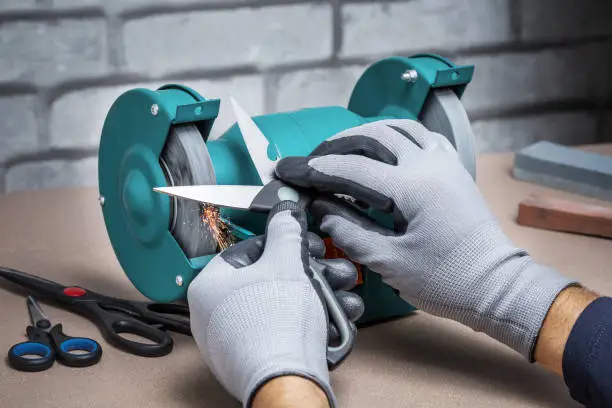Scissors get dull over time. But you don’t need to throw them away. You can make them sharp again at home. It’s easy and safe to do. In this post, we will show you how to sharpen scissors step by step. You don’t need fancy tools. Just follow the guide and your scissors will cut like new!
How Can I Sharpen My Scissors at Home?
Sharpening scissors at home is a straightforward process that doesn’t require professional tools. First, start by cleaning the scissors to remove any adhesive, grime, or residue that may be affecting performance. Once clean, inspect the blades for misalignment or damage. A whetstone is one of the most effective tools for sharpening. Hold the scissors at a 10 to 15-degree angle against the stone and glide the blade along the surface, applying light pressure. For a quick fix, cutting through aluminum foil or sandpaper can help realign the blade edges and restore sharpness. Test the scissors on paper after sharpening to ensure they cut smoothly. If they still feel dull, repeat the process until you achieve the desired sharpness.
How to Fix Scissors That Won’t Cut
When scissors won’t cut effectively, it can be frustrating. Start by examining the blades for any visible signs of damage or misalignment. If the blades are rubbing against each other, they need realignment. Loosen the pivot screw slightly and adjust the blades until they align properly, then retighten the screw. If the blades are dull despite recent sharpening, you may need to repeat the process or consider professional sharpening services. Additionally, ensure you’re using the right type of scissors for the task at hand. Using fabric scissors for paper or vice versa can lead to poor performance. Regular maintenance, such as cleaning and proper storage, can prevent many common cutting issues, ensuring your scissors are always ready to perform.
Does Aluminum Foil Sharpen Scissors?
Cutting aluminum foil is a popular method for sharpening scissors, and many swear by its effectiveness. The fine texture of the foil can help realign the edges of the blades, giving them a quick boost in sharpness. To use this method, fold a sheet of aluminum foil several times to create a thicker piece, then cut through it with your scissors. This process can help hone the blade edges without the need for more traditional sharpening tools. While it’s not a substitute for thorough sharpening with a whetstone, it’s a convenient way to maintain sharpness between regular sharpenings. This method is especially useful for minor dullness and can be a quick fix when you’re short on time or resources.
Does Cutting Sandpaper Sharpen Scissors?
Cutting through sandpaper is another method that can sharpen scissors effectively. The grit on the sandpaper acts as an abrasive, helping to refine the blade edges. However, it’s important to use this method sparingly, as excessive cutting through sandpaper can wear down the blades more quickly than traditional sharpening methods. For best results, choose fine-grit sandpaper and cut through it at a consistent angle. This technique is particularly effective for maintaining sharpness and can be used in conjunction with other sharpening methods, like using a whetstone or aluminum foil. Remember to clean your scissors after using sandpaper to remove any grit or debris that may affect their performance in the future.
Best Tools to Sharpen Scissors
While you can sharpen scissors at home using simple techniques, having the right tools can make a significant difference. Manual sharpeners are often a good choice because they provide you with control over the sharpening angle and pressure. Many come equipped with guides to help maintain the proper angle for the best results. On the other hand, electric sharpeners offer a quick and effortless solution, making them ideal for those who frequently use scissors. While electric options can be convenient, they may not provide the same precision as manual sharpeners. Ultimately, the best tool depends on your personal preference, how often you use your scissors, and the level of precision you require for your sharpening tasks.
Scissor Maintenance Tips for Longevity
Maintaining your scissors is crucial for ensuring they remain sharp and functional for a long time. After each use, wipe the blades with a clean cloth to remove any residue or moisture that can cause rust. For a deeper clean, use mild soap and warm water, making sure to dry them thoroughly afterward. Proper storage is equally important; avoid tossing your scissors in a drawer with other tools, as this can lead to nicks and dullness. Instead, store them in a protective sheath or a designated spot. Additionally, regular inspections for alignment and blade condition will help you catch potential issues early. By following these maintenance tips, you can prolong the life and performance of your scissors.
Common Myths About Scissor Sharpening
There are many misconceptions surrounding scissor sharpening that can lead to ineffective practices. One common myth is that cutting through tough materials, like cardboard, can sharpen scissors. While it may feel like it helps, this method often causes more harm than good, leading to further dulling of the blades. Another misconception is that using a knife sharpener can work for scissors. Scissors and knives have different blade designs and angles, making knife sharpeners unsuitable for scissors. Additionally, some believe that using various household items, such as glass or ceramic, can sharpen scissors. While these items may help realign blades slightly, they do not effectively sharpen. Understanding these myths can help you focus on effective techniques for maintaining your scissors.
When to Seek Professional Scissor Sharpening Services
Sometimes, despite your best efforts, your scissors may still struggle to perform as they should. In such cases, it might be time to consider professional sharpening services. These experts have specialized tools and knowledge to restore your scissors to optimal condition. If your scissors are significantly dull or have sustained damage, seeking professional help can save you time and effort. Regular assessments can help you determine when it’s necessary to consult a professional. Most professionals can handle a variety of scissor types, including fabric scissors, kitchen shears, and specialized tools. By investing in professional sharpening, you ensure that your scissors are not only sharp but also well cared for, ultimately extending their lifespan.
Understanding Scissor Blade Materials
When it comes to scissors, the type of blade material can significantly impact their sharpness and longevity. Scissors are typically made from different types of steel, each offering unique benefits. Understanding these materials can help you choose the right scissors for your needs and maintain them effectively.
Types of Blade Materials
- Stainless Steel: This is one of the most common materials used in scissors. Stainless steel is resistant to rust and corrosion, making it ideal for kitchen scissors or those used in humid environments. However, it can dull more quickly than other metals, which means regular sharpening is necessary to maintain its cutting edge.
- Carbon Steel: Carbon steel scissors are known for their superior sharpness and edge retention. They hold their edge longer than stainless steel, which means less frequent sharpening. However, they are more prone to rust, so proper cleaning and storage are essential to prevent corrosion.
- High-Carbon Stainless Steel: This material combines the benefits of both stainless and carbon steel. It offers excellent sharpness, edge retention, and resistance to rust. Scissors made from high-carbon stainless steel are often seen as high-quality tools suitable for professional use.
- Ceramic Blades: Some modern scissors come with ceramic blades. These blades are extremely sharp and stay sharp longer than steel blades. However, they can be brittle and may chip or break if dropped. Ceramic blades are great for specific tasks but are not as versatile as steel.
Choosing the Right Scissors
When selecting scissors, consider the tasks you’ll be using them for. If you’re looking for kitchen scissors, stainless steel is often the best choice due to its rust resistance. For crafting or sewing, high-carbon stainless steel scissors may provide the sharpness you need. Understanding the material of your scissors can help you maintain them better and ensure you have the right tool for the job.
By keeping these factors in mind, you can enhance your scissor experience and prolong their lifespan.
You May Also Like: What Does AR Stand For? Simple Answer for Everyone
Conclusion
Now you know how to sharpen scissors. It’s simple and doesn’t take long. You can do it anytime your scissors feel dull. Keep your tools sharp and safe. Just follow these steps and enjoy smooth cutting again!
FAQs
How often should I sharpen my scissors?
Regularly assess your scissors, sharpening them every few months or whenever they feel dull.
Can I sharpen kitchen scissors the same way?
Yes, kitchen scissors can be sharpened using the same methods as regular scissors.
What’s the best way to store scissors?
Store scissors in a protective sheath or case to prevent dulling and damage.
Are there specific scissors that require special sharpening?
Yes, certain scissors, like pinking shears, may require specialized sharpening techniques.
Is it worth investing in an electric sharpener?
If you frequently use scissors, an electric sharpener can be a time-saving investment.
For more tips and detailed guides, feel free to visit Try Hard Guides.

Alex Taylor is a seasoned writer and editor with over 5 years in digital media, specializing in practical home maintenance guides and homeowner tips. From heating system upkeep to seasonal repair checklists, Alex blends clear, relatable advice with real-world experience to help readers protect their homes and budgets. He personally reviews and fact-checks every article in his areas of expertise to ensure accuracy, clarity, and real-world usefulness. His work also spans tech, culture, fashion, sports, and lifestyle—always with a focus on clarity, relevance, and reader value.
Discover more from Try Hard Guides
Subscribe to get the latest posts sent to your email.

